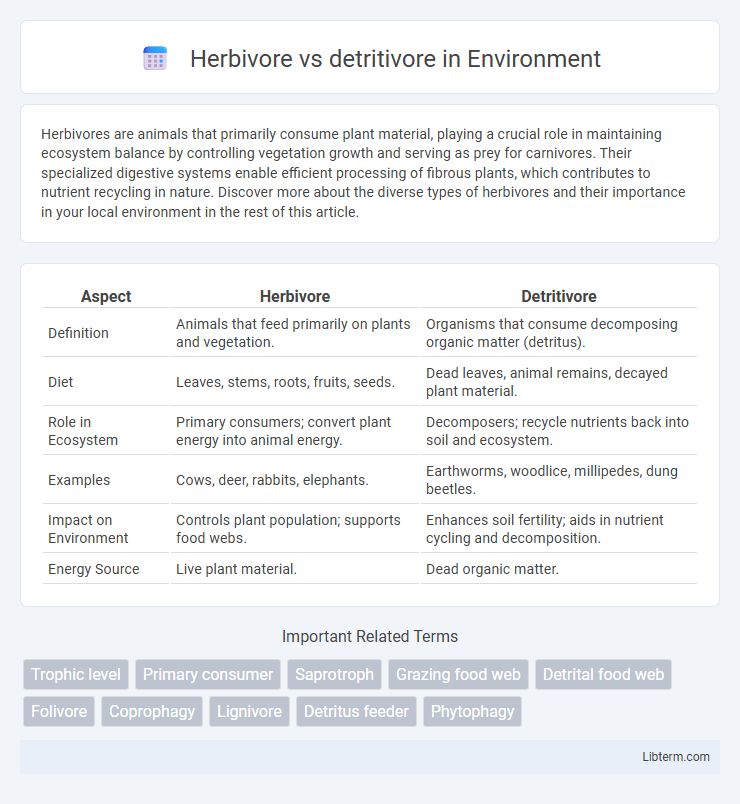Herbivores are animals that primarily consume plant material, playing a crucial role in maintaining ecosystem balance by controlling vegetation growth and serving as prey for carnivores. Their specialized digestive systems enable efficient processing of fibrous plants, which contributes to nutrient recycling in nature. Discover more about the diverse types of herbivores and their importance in your local environment in the rest of this article.
Table of Comparison
| Aspect | Herbivore | Detritivore |
|---|---|---|
| Definition | Animals that feed primarily on plants and vegetation. | Organisms that consume decomposing organic matter (detritus). |
| Diet | Leaves, stems, roots, fruits, seeds. | Dead leaves, animal remains, decayed plant material. |
| Role in Ecosystem | Primary consumers; convert plant energy into animal energy. | Decomposers; recycle nutrients back into soil and ecosystem. |
| Examples | Cows, deer, rabbits, elephants. | Earthworms, woodlice, millipedes, dung beetles. |
| Impact on Environment | Controls plant population; supports food webs. | Enhances soil fertility; aids in nutrient cycling and decomposition. |
| Energy Source | Live plant material. | Dead organic matter. |
Introduction to Herbivores and Detritivores
Herbivores are animals that primarily consume plants, playing a vital role in ecosystems by transferring energy from producers to higher trophic levels. Detritivores, in contrast, feed on decomposing organic matter, breaking down dead plants and animals to recycle nutrients back into the soil. Both herbivores and detritivores contribute to nutrient cycling but operate through distinct feeding habits and ecological functions.
Defining Herbivores: Characteristics and Diet
Herbivores are animals that primarily consume plant material, including leaves, stems, fruits, and seeds, relying on photosynthetic organisms for nutrition. They exhibit specialized adaptations such as flat molars for grinding fibrous plant tissue and elongated digestive tracts to efficiently process cellulose. Prominent examples include deer, rabbits, and cows, which play a crucial role in maintaining ecosystem balance by regulating vegetation growth.
Defining Detritivores: Roles and Food Sources
Detritivores are organisms that feed on decomposing organic matter, playing a crucial role in nutrient cycling by breaking down dead plants and animals into simpler substances. Unlike herbivores that consume living plant material, detritivores obtain energy from detritus, including leaf litter, dead wood, and animal carcasses. Key detritivores include earthworms, woodlice, and certain insect larvae, all essential for maintaining soil health and ecosystem stability.
Key Differences Between Herbivores and Detritivores
Herbivores primarily consume living plant material such as leaves, stems, and roots, playing a crucial role in energy transfer within ecosystems by converting plant biomass into animal biomass. Detritivores feed on decomposing organic matter, including dead plants and animals, facilitating nutrient recycling and soil formation by breaking down complex organic substances. The key difference lies in their food sources and ecological functions: herbivores directly consume autotrophs, while detritivores process detritus, contributing to ecosystem nutrient cycling.
Adaptations in Herbivores vs. Detritivores
Herbivores have specialized teeth, such as molars with flat surfaces, and elongated digestive tracts to efficiently break down cellulose from plant material. Detritivores exhibit adaptations like strong mandibles or claws for shredding decomposing organic matter and possess symbiotic gut microbes to aid in the digestion of complex organic compounds. These physiological and anatomical adaptations enable herbivores and detritivores to exploit different niches in ecosystems by optimizing nutrient extraction from their respective food sources.
Ecological Roles in Ecosystems
Herbivores play a crucial ecological role by consuming plants, which helps regulate vegetation growth and facilitates energy transfer from primary producers to higher trophic levels. Detritivores contribute to ecosystem nutrient cycling by breaking down dead organic matter and recycling essential nutrients back into the soil, supporting plant growth and maintaining soil health. Together, herbivores and detritivores maintain ecosystem balance through complementary processes of energy flow and matter decomposition.
Examples of Common Herbivores
Common herbivores include animals such as deer, rabbits, and cows that primarily consume plant material like leaves, grasses, and stems. These species play essential roles in ecosystems by regulating plant populations and facilitating nutrient cycling through digestion. Unlike detritivores, which feed on decomposing organic matter, herbivores directly impact vegetation and serve as prey for numerous carnivorous animals.
Examples of Common Detritivores
Common detritivores include earthworms, woodlice, and dung beetles, which play a crucial role in breaking down decomposing organic matter into nutrients that enrich the soil. Unlike herbivores that consume living plant material, detritivores feed on dead plant and animal matter, facilitating nutrient cycling in ecosystems. Fungi and certain types of bacteria also function as detritivores, accelerating decomposition and maintaining ecological balance.
Importance in Food Chains and Nutrient Cycles
Herbivores play a crucial role in food chains by transferring energy from plants to higher trophic levels, directly supporting predators and maintaining ecosystem balance. Detritivores, by decomposing dead organic matter, facilitate nutrient cycling, releasing essential nutrients back into the soil to promote plant growth and sustain primary producers. Together, herbivores and detritivores ensure energy flow and nutrient recycling, underpinning ecosystem productivity and resilience.
Conclusion: Comparing Herbivores and Detritivores
Herbivores primarily consume living plant material, playing a crucial role in controlling plant populations and transferring energy in ecosystems. Detritivores feed on decomposing organic matter, facilitating nutrient recycling and soil fertility by breaking down dead organisms. Both groups are essential for ecosystem balance, with herbivores influencing primary production dynamics and detritivores enhancing decomposition processes.
Herbivore Infographic

 libterm.com
libterm.com